American pilots from ... Penza!
We go on the last wing.
Buck pierced, tail burning
And the car flies
On parole and on one wing.
("Bombers", Leonid Utesov)
"Contracts must be respected!"
War is war and politics is politics! At the same time, it is not necessary to forget about the economy either. Therefore, it often happens that yesterday’s allies become today's enemies (the enemies promised more, so the allies bought it!), And vice versa. So it was, for example, with Italy in the First World War and with Japan ... in the Second. It would seem that, being an ally of fascist Germany, she would have to put all her strength into war with Soviet Russia, but ... even a victory over the latter would not have given her oil! And oil is the blood of war! Meanwhile, the American oil embargo would strangle the Japanese economy. Here are the Japanese and began a war with England and the United States. And with the USSR, Japan had signed a non-aggression pact, and it was more or less respected. That just gave birth to a certain incident. According to him, all the American crews of planes shot down over Japan, which turned out to be in the USSR after that, were to be interned! Moreover, there were quite a lot of such crews of the US Air Forces and the US Navy interned in the USSR during the war years. Their planes were damaged, they ran out of fuel, and they flew to their allies, that is, in the USSR.
It was then that it turned out that, as allies of the United States in the anti-Hitler coalition, we did not fight with Japan. And according to the norms of international law then existing, since there was no war between us, the Americans who had fallen to us during the hostilities against the Japanese side had to be kept in the camp “for displaced persons” before the end of the war! It is ridiculous, of course, but "contracts must be respected." Well, the first crew who happened to experience all the charms of political “de facto” and “de jure” became, surprisingly, the pilots of the squadron of the famous lieutenant colonel Jimmy Doolittle, 18 on April 1942 of the year who made a daring raid on the capital of Japan.
"The Empire Strikes Back!"
And it was so that the US Navy headquarters was extremely concerned about the need to respond with a blow to Japan after Pearl Harbor. It was supposed to be a great PR, for which, however, there was neither strength nor opportunity. The solution was found by Jimmy Dulittl: to bomb Japan with the help of ground-based B-25 "Mitchell" twin-engine bombers, which were supposed to take off from two aircraft carriers. It was prepared two options for the raid. The first one was optimal, it involved a strike from a distance of 500 miles. Immediately after this, the aircraft carriers had to depart, and the bombed aircraft caught up and sat down.
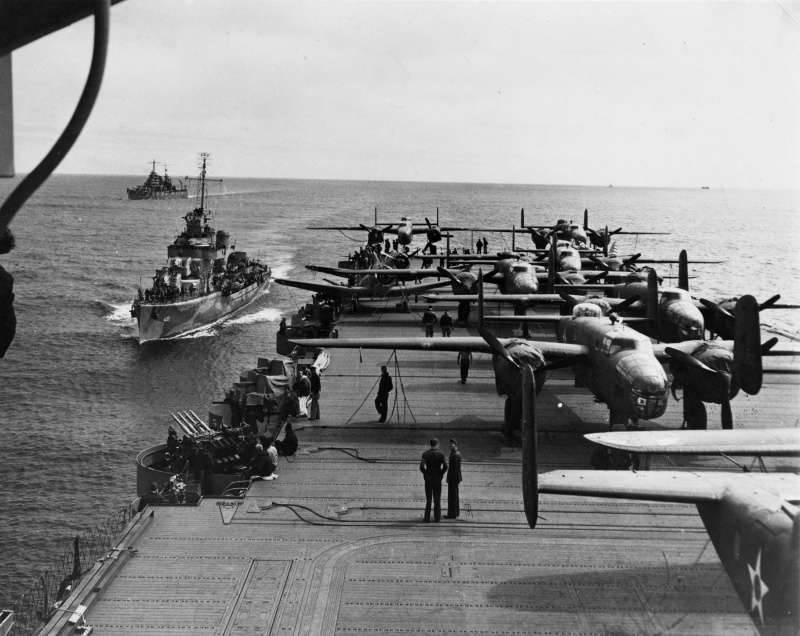
The aircraft carrier "Hornet" with aircraft B-25 on the deck.
The second option was a backup. In case the operation went "wrong", the planes should fly to China, get to the territory occupied by the troops of General Chiang Kai-shek, and get on the airfield in Huzhou province, 200 miles south-west of Shanghai.
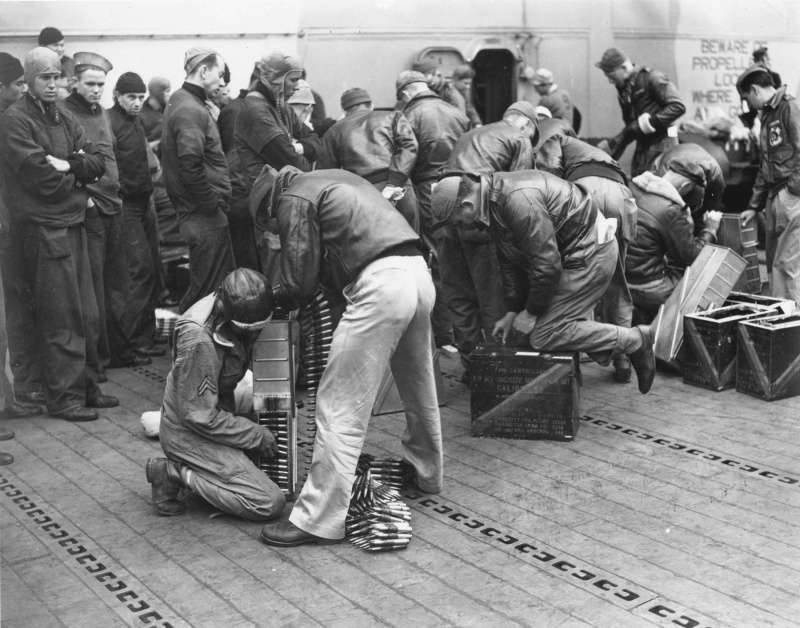
These are the 12,7-mm machine-gun belts prepared for laying in the aircraft on the deck of the Hornet.
“Not so” began 18 on April 1942, when the American ships were at a distance of 750 miles from the coast of Japan, aerial reconnaissance from the aircraft carrier Enterprise had discovered the patrol vessel Nitto Maru. The ship was immediately sunk, but it was too late. The Japanese had already sent a signal to headquarters, so the response to the invasion by airplanes or ships could follow at any minute! However, the commanding fathers in charge of the operation decided to take the risk, and Doolittle gave the order to lift the Mitchells into the air. Sixteen bombers headed for Japan, and the aircraft carrier compound immediately turned east. The eighth in 8.35 took off the plane of Captain Edward York. The Americans managed at low altitudes to approach the Japanese coast and drop bombs on Tokyo, Kanazawa, Yokohama, Yokosuka, Kobe, Osaka and Nagoya. Not a single aircraft was shot down over Japan, that is, the raid was a complete success. The slap turned out to be awesome, which President Franklin Roosevelt immediately said, speaking on this issue on national radio. He then said that the planes took off from Shangri-La, a country born of the fantasy of the English writer James Hilton, who located it in the Himalayan mountains. Then, of course, nothing was said about what happened to the crews of these aircraft: they are alive or dead - all this was hidden by a “military secret”. Meanwhile, none of the 16 aircraft could not reach the airfield they needed due to the lack of fuel. Part of it fell into the sea, and their pilots escaped by parachute. Eight were captured by the Japanese, and they beheaded three of them, and another pilot died in the camp. But the 64 pilots did manage to get to the Chinese partisans and not soon, but still return to the United States. Among those who returned was Lieutenant Colonel Jim Dulittle, who immediately became a national hero.
But Captain Edward York, the crew commander No. XXUMX, turned out to be “the smartest.” Dropping bombs, and, calculating fuel consumption, he realized that he could not fly to China and headed northwest to Russia ... The crew members of York were: co-pilot - 8-th lieutenant Robert J. Emmens, navigator - 1- Lieutenant Nolan A. Herndon, flight engineer - staff sergeant Theodore X. Leben and gunner-radio operator - Corporal David V. Paul.
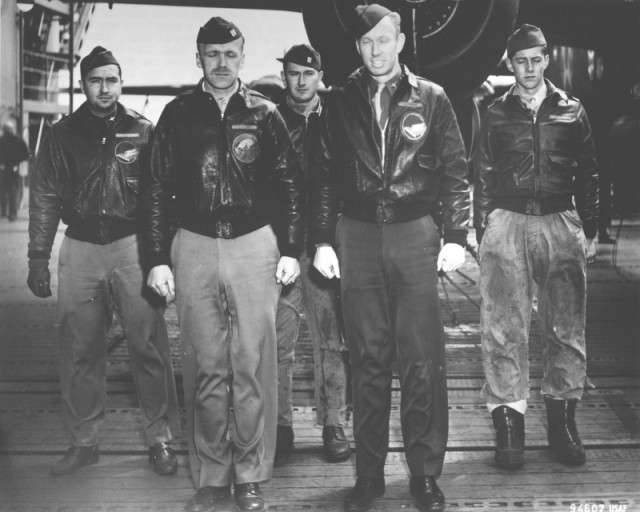
Crew №8, participated in the "Doolittle raid". The aircraft number is 40-2242. The goal is Tokyo. 95-I bomber squadron. In the first row, from left to right: the crew commander - the first pilot, captain Edward York; the co-pilot, 1 th lieutenant Robert Emmens. In the second row, from left to right: navigator-scorer, Lieutenant Nolan Herndon; flight engineer, staff sergeant Theodore Leben; gunner - Corporal David Paul.
Orders must be carried out!
After nine hours of flight, the Americans crossed the coastline and began to search for a landing site. Archival documents and, in particular, memorandum of the Chief of Staff of the Pacific fleet Rear Admiral V. Bogdenko, Air Force Chief of the Navy of the USSR, Lieutenant General S. Zhavoronkov, noted that the B-25 was spotted by the air surveillance, warning and communications post (WMO) No. 7516 of the 19th Separate Air Defense Regiment of the Pacific Fleet at Cape Sysoev. But those who were on duty showed carelessness and ... took the American bomber for our Yak-4, whose flight they simply did not notify. Therefore, the alarm was not announced, and the American plane both flew and flew. Then he was again noticed, again identified as the Yak-4, and "where necessary" was not reported. Then, nevertheless, a message arrived, but the anti-aircraft gunners of the 140th battery, although the American plane flew in their fire zone for two minutes, did not pay attention to the order of their operational duty officer and continued to do their own business (then all officials will be punished for negligence).
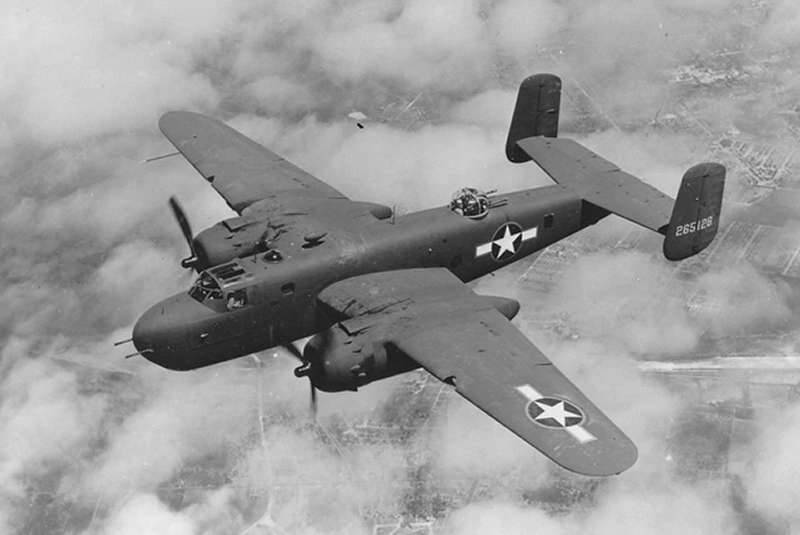
B-25 in the air.
And York continued to fly heading north, trying to quickly network. It was then that two I-15, engaged in the training of group fights, came to him. Seeing an unknown plane, they immediately went to intercept, but did not open fire. And the Americans understood it so that they were met and immediately landed on Unashi airfield, leaving behind the 9 hours of exceptionally difficult flight. It was difficult to explain to the pilots who sat down and the owners - none of them knew English, and their guests did not speak Russian. But York showed on the map that they had flown in from Alaska. Well, and then the Allies began to feed and water, the authorities came along with a translator, and in the meantime, the message about the landing American plane arrived in Moscow. An urgent order came from there - to deliver the pilots to Khabarovsk, to the headquarters of the Far Eastern Front. Already on board the aircraft they were told that ... they are interned! Surprised Americans found it hard to understand why this Soviet command did not allow them to fly to China, because the plane was working properly.

“Battle Coloring” B-25.
Forced tour of Soviet Russia
And then their real “wanderings” around Russia, or, rather, “forced tour”, began. First, they were transported from Khabarovsk to the city of Kuibyshev (Samara). But there was a Japanese diplomatic mission and they were transported away from sin to the next ... Penza. And not just in Penza, but the village near Penza Akhuna, where they began to live and live under the supervision of Soviet officers. They were also served by a translator and as many as seven women who cleaned the house and prepared their meals. In general, they lived very well.
Today, the Akhuny is a recreation area recognized by the Penzens. There are several sanatoriums located there, there is a beautiful pine forest, a small river flows through the village, in a word, although there are very many here (there is a school, a technical school, a library and an agricultural academy!), They mostly come here to have a rest. Getting to the city, however, is not so easy, as one road leads there and the forest around it is marshy.
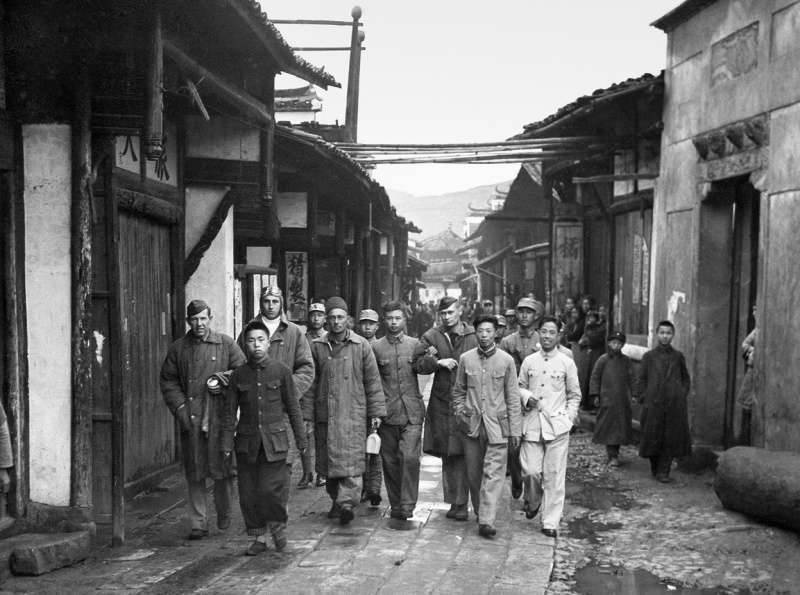
American pilots crew number XXUMX in the Chinese village.
Well, at that time it was just a big village, from where it was before the city - oh, how many. So that you yourself will not run away from there (where should you run?), And no one there will find you! The Penza historian Pavel Arzamastsev tried to find out where exactly what house the Americans lived in, but he did not succeed. But the fact that they lived there is undoubtedly and strangely, while walking along the forest paths there, among the fences of pioneer camps, old shacks and new-fashioned cottages, to know that English was once heard here, and American pilots could walk who bombed Japan!
But our authorities did not like something in Akhuny and the Americans were sent to the city of Okhansk near Perm. They lived there for seven months, and American diplomats came to them there, and they delivered letters from their homeland, in a word, “life got better”. Navigator Bob Roberbs almost got married to their Russian mistress there. But it was very cold there, and the pilots were asked where it was warmer.
7 January 1943, they wrote a letter in two languages at once - to the Chief of the General Staff of the Red Army, Colonel-General Alexander Vasilevsky, with the expectation that Stalin would be reported to him. At the same time, Yorke's wife turned to the US president and asked for help to “return her husband.” And ... work has begun!
South, South!
And when the Americans really were about to flee, they were told about the transfer to Tashkent, and then, on Stalin’s personal instructions, they began to prepare an operation to prepare for the “escape” of pilots from the USSR. And everything had to be done so that the Americans themselves would be sure that they conceived this escape and fled themselves, that the Russians did not help them!
For this purpose, even a false border strip, imitating the Soviet-Iranian border, was equipped near Ashgabat. So that everything would be like “really,” because in reality there was no “border” there. Then a smuggler was sent to them, who offered to transfer them to the border for money and even told them how to find a British consulate in Mashhad. Well, and then at night they were put into a truck and with all the precautions taken to the border, where they, looking around and sneaking, climbed under barbed wire and ... found themselves in Iran! But it was still the Soviet occupation zone, so the British also carried them secretly, circling the Soviet checkpoints! On the Pakistani border they were met ... a wooden fence (!), Which they broke down and it was then that they became truly free!
On the same day 20 May they were put on an American plane and sent to Karachi. And then in an absolute secrecy, the pilots of the B-25 were taken through the Middle East, North Africa and South Atlantic to Miami to Florida. Here they were given a rest, after which 24 May was sent to Washington, where he was personally presented to the US President. So ended the 14-month odyssey of the American pilots who bombed Japan, but by chance turned up in the USSR!
Information